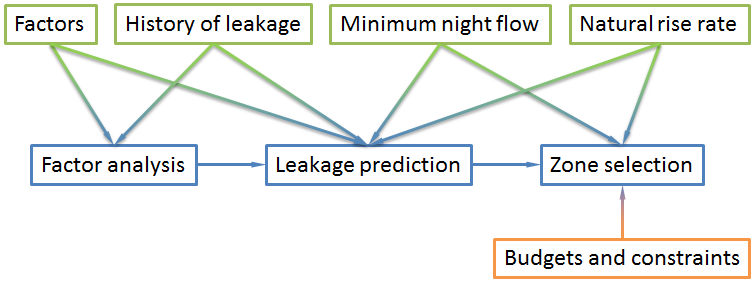Active Leakage Detection
Data-driven, predictive maintenance for asset management
Background
Water main failure is one of the major challenges to water utilities’ daily operation and maintenance. Leakage is a concealed failure that occurs underground unnoticeably before developing into an observable state resulting in high economic lost. Therefore, leakage prediction and the corresponding maintenance strategy optimization become of great significance. Water Utilities have invested tremendous resources on actively tackling leakage and repairing pipes. This project aims to prioritise water network zones to target the active leak detection program which are pipes less than 375 mm in diameter, by solving three major challenges:
Factor complexity
- There are a variety of potential factors causing the leakage, such as pipe age, material, pressure, traffic load, and so on. It is difficult to identify those significant ones for different pipes in different zones.
Unknown leaking probability
- The failure mode must consider all factors before estimating the probabilities of pipes’ leaking status and further determining which pipes to inspect. Furthermore, the way of failure mode considering these factors may be very different for each pipe.
Practical issue in zone selection
- Formulating the globally optimized maintenance strategy, based on leaking probabilities by selecting inspection zones, is also essential for the practical operation. Moreover, some practical constraints must be involved in the optimization.
Technologies
The framework (Figure 1) of this project consists of three components:
Factor analysis
- Data calibration and aggregation
- Significance of single factors
- Significance of combined factors
Leakage prediction
- Group the pipes by selected factors
- Leaking probability estimation
- Leaking status estimation
Zone selection optimisation
- Optimise the selection based on both leaking status and economic costs
- Involve more constraints to refine the selection
The methods involved in the model construction include:
Quantitative evaluation of correlations
- To determine which factor is important, information gain and correlation coefficient for single factor and multiple factors
Bayesian nonparametric modelling (Figure 2)
- Predict the probability of leakage with hidden factors
- Avoid unnecessary assumptions that can cause bias when predicting the probabilities
Hierarchical structure
- Involve dependencies between pipes and zones
Binary integer programming
- Optimise the zone selection with the combination of predicted leaking probability, minimum night flow, natural rise rate, and constraints

Figure 1: The framework to select zones for active leakage detection
Outcomes
This project mainly provides four aspects of outcomes for SW to prioritise the active leakage areas:
Quantitative indicators of correlations of single/multiple factors and leakage
- Help to select useful factors
- Can direct the future data collection
Probability of leakage for each pipe
- Rank pipes according to the priority of inspection
- Help to detect the leakage that are concealed on the buried pipes
Colour coded GIS maps
- Display the spatial distribution of factors
- Indicate the leakage risk on the pipe layer
- Indicate the selected zones with their potential savings
Selected zones
- Automatically determine the zones for inspection
- Economic saving by inspecting the selected zones
